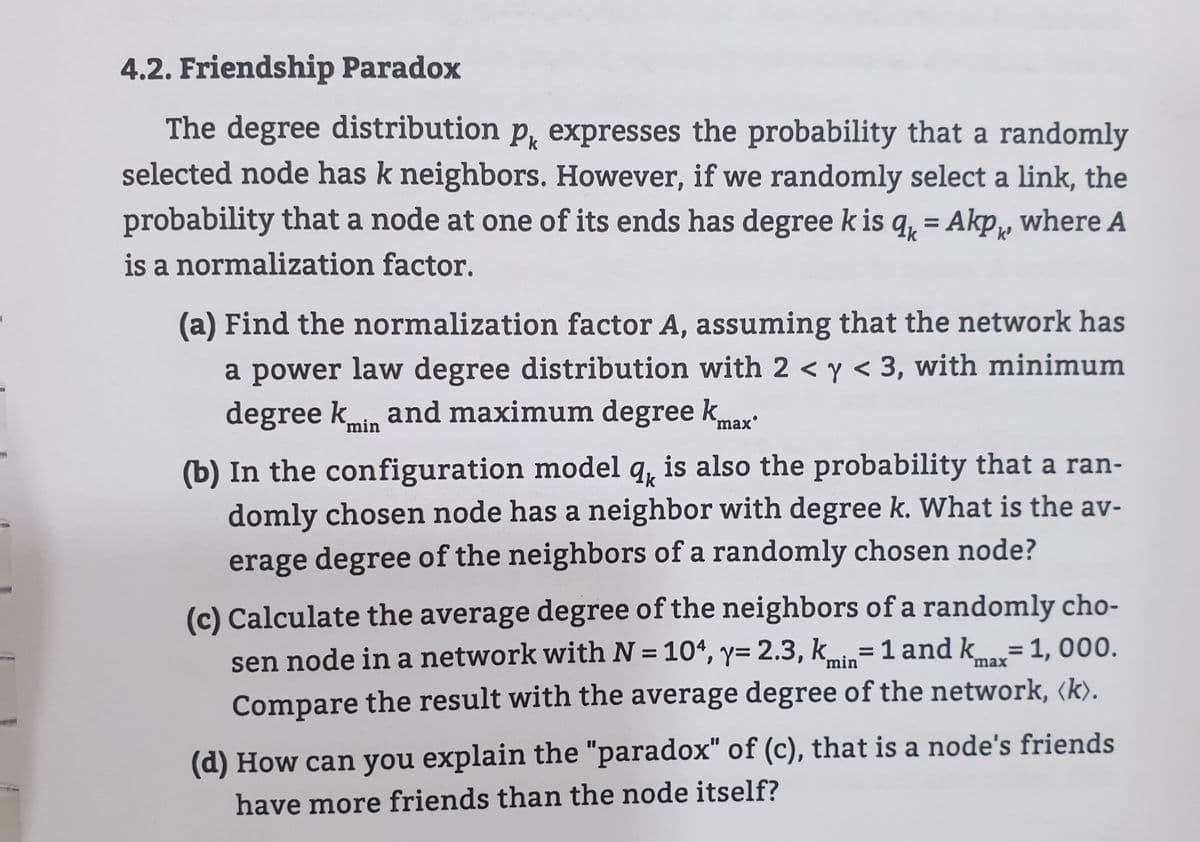4.2. Friendship Paradox The degree distribution p, expresses the probability that a randomly selected node has k neighbors. However, if we randomly select a link, the probability that a node at one of its ends has degree k is q, = Akp, where A %3D is a normalization factor. (a) Find the normalization factor A, assuming that the network has
4.2. Friendship Paradox The degree distribution p, expresses the probability that a randomly selected node has k neighbors. However, if we randomly select a link, the probability that a node at one of its ends has degree k is q, = Akp, where A %3D is a normalization factor. (a) Find the normalization factor A, assuming that the network has
Database System Concepts
7th Edition
ISBN:9780078022159
Author:Abraham Silberschatz Professor, Henry F. Korth, S. Sudarshan
Publisher:Abraham Silberschatz Professor, Henry F. Korth, S. Sudarshan
Chapter1: Introduction
Section: Chapter Questions
Problem 1PE
Related questions
Question
could you answer the question please?

Transcribed Image Text:4.2. Friendship Paradox
The degree distribution p, expresses the probability that a randomly
selected node has k neighbors. However, if we randomly select a link, the
probability that a node at one of its ends has degree k is q, = Akp, where A
is a normalization factor.
(a) Find the normalization factor A, assuming that the network has
a power law degree distribution with 2 < y < 3, with minimum
degree kin and maximum degree k
max'
(b) In the configuration model q, is also the probability that a ran-
domly chosen node has a neighbor with degree k. What is the av-
erage degree of the neighbors of a randomly chosen node?
(c) Calculate the average degree of the neighbors of a randomly cho-
sen node in a network with N = 104, y= 2.3, kmin=1 and k=1, 000.
%3D
%3D
%3D
max
Compare the result with the average degree of the network, (k).
(d) How can you explain the "paradox" of (c), that is a node's friends
have more friends than the node itself?
Expert Solution
This question has been solved!
Explore an expertly crafted, step-by-step solution for a thorough understanding of key concepts.
This is a popular solution!
Trending now
This is a popular solution!
Step by step
Solved in 2 steps with 1 images

Knowledge Booster
Learn more about
Need a deep-dive on the concept behind this application? Look no further. Learn more about this topic, computer-science and related others by exploring similar questions and additional content below.Recommended textbooks for you

Database System Concepts
Computer Science
ISBN:
9780078022159
Author:
Abraham Silberschatz Professor, Henry F. Korth, S. Sudarshan
Publisher:
McGraw-Hill Education

Starting Out with Python (4th Edition)
Computer Science
ISBN:
9780134444321
Author:
Tony Gaddis
Publisher:
PEARSON

Digital Fundamentals (11th Edition)
Computer Science
ISBN:
9780132737968
Author:
Thomas L. Floyd
Publisher:
PEARSON

Database System Concepts
Computer Science
ISBN:
9780078022159
Author:
Abraham Silberschatz Professor, Henry F. Korth, S. Sudarshan
Publisher:
McGraw-Hill Education

Starting Out with Python (4th Edition)
Computer Science
ISBN:
9780134444321
Author:
Tony Gaddis
Publisher:
PEARSON

Digital Fundamentals (11th Edition)
Computer Science
ISBN:
9780132737968
Author:
Thomas L. Floyd
Publisher:
PEARSON

C How to Program (8th Edition)
Computer Science
ISBN:
9780133976892
Author:
Paul J. Deitel, Harvey Deitel
Publisher:
PEARSON

Database Systems: Design, Implementation, & Manag…
Computer Science
ISBN:
9781337627900
Author:
Carlos Coronel, Steven Morris
Publisher:
Cengage Learning

Programmable Logic Controllers
Computer Science
ISBN:
9780073373843
Author:
Frank D. Petruzella
Publisher:
McGraw-Hill Education